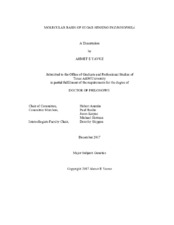| dc.description.abstract | In contrast to mammals, which sense sweet tasting molecules through a single,
dimeric sugar taste receptor, Drosophila melanogaster use at least eight sugar gustatory
receptor (Gr) proteins to recognize a range of dietary sugars. We showed that the sugar
Gr genes are expressed in partially overlapping fashion in the single sweet gustatory
receptor neuron (GRN) to generate at least 8 different subtypes and that sugar receptors
heteromultimeric complexes. We used a combinatorial strategy to examine the
composition of functional sugar receptors using an “empty neuron” system that is based
on an octuple mutant fly strain lacking all eight sugar Gr genes. By expressing all 28
possible pairwise Gr gene combinations in the “empty neuron” that express the Ca^2+
sensitive GCaMP6 protein, we find that 18 of these combinations can reconstitute sugar
responses to a subset of sugars. Remarkably, each of these combinations restores
responses to wild type levels to at least one of the eight sugars that we tested, and some
combinations restored high responses to two or three sugars. Some of these
combinations were able to convey sugar responses to bitter GRNs when expressed under
the control of the GAL4 driver for the bitter receptor Gr33a, indicating that bitter and
sweet GRNs use the same signaling mechanism. To explore the possibility whether
sugar receptor complexes are composed of more than two different subunits, we
introduced triple combinations of sugar Gr genes in the “empty neuron”. For two of the
four different triple combinations, response profile revealed new sugar responses not
observed with any of the three respective pairwise combinations, suggesting that for at least some sugars, functional complexes are likely to contain three different Gr subunits.
Taken together, our analysis reveals that sweet GRNs of wild type flies might have more
than 20 different sugar receptor complexes, each tuned to subsets of sugars. | en |


